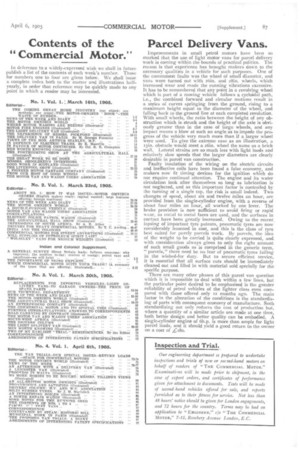Parcel Delivery Vans.
Page 15

If you've noticed an error in this article please click here to report it so we can fix it.
Improvements in small petrol motors have been so marked that the use of light motor vans for parcel delivery work is coming within the bounds of practical politics. The reason is that experience has brought makers down to the necessary qualities in a vehicle for such purposes. One of the commonest faults was the wheel of small diameter, and vans were turned out with 26in. and 28in. wheels, which increased wear and made the running vibrations excessive. It has to be remembered that any point in a revolving wheel which is part of a moving vehicle follows a cycloidal path, i.e., the combined forward and circular motions result in a series of curves springing from the ground, rising to a maximum height equal to the diameter of the wheel, and falling back to the ground line at each completed revolution. With small wheels, the ratio between the height of any obstruction which is struck and the height of the axle is obviously greater than in the case of large wheels, and any impact means a blow at such an angle as to impede the progress of the vehicle very much more than if a larger wheel were used. To give the extreme case as an illustration, a I3in. obstacle would meet a 26in, wheel the same as a brick wall. Lateral strains are so much less with light loads and relatively slow speeds that the larger diameters are clearly desirable in parcel van construction. Faulty insulation of the wiring on the electric circuits and ineffective coils have been found a false economy, and makers now fit timing devices for the ignition which do not require continual attention. The engine and its water circulation look after themselves so long as lubrication is not neglected, and as this important factor is controlled by the turning of a single tap, the risk is small indeed. Two changes of speed, about six and twelve miles an hour, are provided from the single-cylinder engine, with a reverse of about four miles an hour, all worked by one lever. The brake provision is now sufficient to avoid firing or rapid w ear, as metal to metal faces are used, and the surfaces in contact have been greatly increased. Owing to the recent lapsing of important tyre patents, pneumatic tyres are now considerably lessened in cost, and this is the class of tyre
best suited for purely parcels work. By parcels, the idea of the weight to be carried is quite clearly expressed, and with consideration always given to only the right amount of such small goods as is comprised in the generic term,
"parcels," there need be no fear of pneumatic tyres failing in the wished-for duty. But to secure efficient service, it is essential that all surface cuts should be immediately cleaned out and filled in with material sold specially for the specific purpose. There are many other phases of this parcel van question which it is impossible to deal with within a few lines, but the particular point desired to be emphasised is the greater reliability of petrol vehicles of the lighter class even compared with those offered only 12 months ago. The main factor in the alteration of the conditions is the standardising of parts with consequent economy of manufacture. Such standardising not only reduces the cost of production but, where a quantity of a similar article are made at one time, both better design and better quality can be embodied. A single-cylinder engine of 6h.p. is more than ample for light parcel loads, and it should yield a good return to the owner on a cost of Zak,.




















